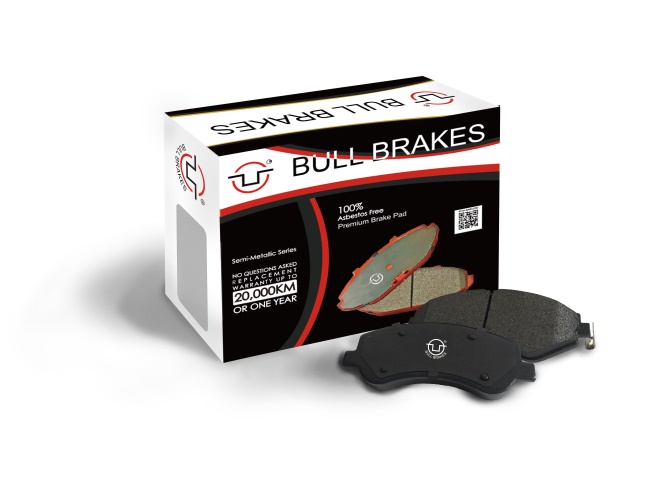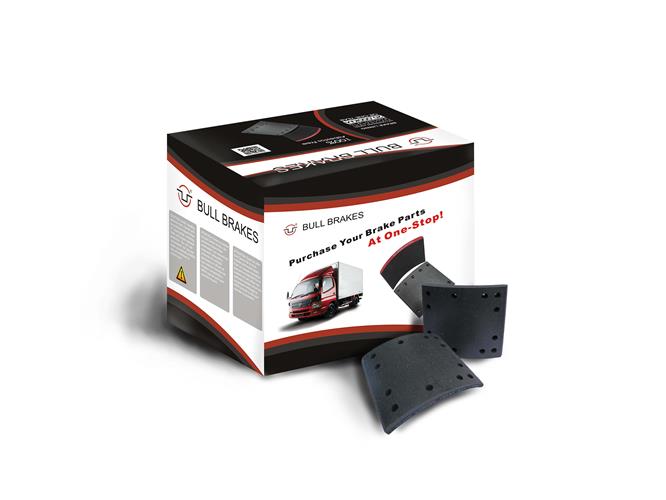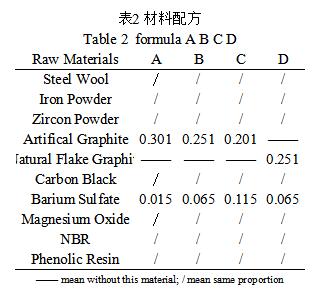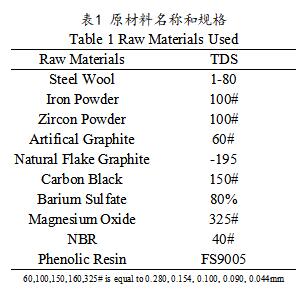This article studies the adhesion and lubrication of graphite in semi-metallic friction materials, as well as the effects of different contents of artificial graphite on friction properties including friction coefficient, friction stability (stability of friction coefficient changing with temperature) and volumetric wear rate. And also compared with natural flake graphite. Due to the special adhesion of graphite, graphite can improve the friction coefficient within a certain friction temperature range. As a lubricant, graphite can effectively reduce the wear rate by reducing the direct friction between the friction material and the rough peaks on the friction disk surface.



PC Brake Pads CV Brake Pads CV Brake Linings
Friction materials play an important role in the safe driving of automobiles and the protection of human life. Automotive friction materials are multi-component, multi-phase composite materials, composed of fibers, fillers and resin binders. Industrial friction material formulations generally have 7-20 raw material components. The selection and uation of raw materials is an important content of friction materials research. Raw materials are also diverse, there are different types, different shapes and sizes, different crystal types, and different production processes, these factors all will affect the friction properties of friction materials. In addition to the influence of raw materials, during the friction process, the metal phase (mainly iron), carbon phase and barium sulfate phase and tribochemical reaction products can form a friction layer on the friction surface and affect the friction performance.
The carbon phase can be composed of carbon materials such as graphite and carbon black, and can also be composed of carbonized products of organic substances such as phenolic resin, aromatic and rubber. Graphite is a commonly used lubricant in friction materials and has a layered crystal structure. Graphite is divided into natural and artificial graphite, and different shapes and sizes. Different types of graphite and different shapes and sizes have a great influence on friction performance. In this article, natural and artificial graphite are used to prepare semi-metallic friction materials by two-component variable method. The role of different types and sizes of graphite in friction materials and their friction properties including friction coefficient (μ), friction stability (stability of friction coefficient changing with temperature) and volumetric wear rate. Friction stability is an important indicator of the performance of friction materials.
1. Experiment
(1)Raw Material and Friction Material Formula

10 kinds of raw materials are used, see table 1. Since barium sulfate mainly plays a role in filling volume and reducing costs in semi-metal friction materials. Therefore, with graphite and barium sulfate as variables, that is, the increase in graphite content and the corresponding decrease in barium sulfate content, the friction material formula designed to reflect the role of graphite is shown in Table 2.
(2)Brake Pads Making and Heat Treatment
Raw materials are mixed with a high-speed mixer(lab level) for 2 minutes; then hot pressing with a 400 Tons hot press machine at a temperature of 175°C, a pressure of 25 MPa for 8 minutes. Oven curing at 170°C for 3h.
(3)Friction performance Determination
The friction performance is tested by a fixed-speed friction tester according to the friction performance test method specified in the fourth class of disc brake linings in GB5763-1998. The size of the friction material sample is 25 mm x 25 mm x 6 mm, the pressure is 0.98 MPa, the friction disc material is cast iron, the rotation speed is constant at 480r/min., the test temperature is 100℃, 150℃, 200℃, 250℃, 300 ℃ and 350 ℃, at each temperature point, record friction coefficient of the friction material (expressed in μf), by 5000 rotations of fixed-speed friction tester, and the volume wear rate (unit is 10-7cm3/Nm).Then, the temperature was reduced from 300℃ to 250℃, 200℃, 150℃ and 100℃, and at each temperature point, record the friction coefficient of the friction material (expressed in μr), by 1500 rotations of fixed-speed friction tester.
2.Results and Discussion
(1)Effects of artificial graphite content and friction temperature on friction performance 
The effect of different contents of artificial graphite (Formula 1-3) on μf and μr is shown in Figure 1. Graphite is a soft and flexible material. During the friction process, the grinding caused by wear will gather on the surface of the friction material to form a carbon phase (friction layer) and transfer to the friction disk to show adhesion characteristics. Therefore, within a certain temperature range, graphite can increase the coefficient of friction. However, if the temperature is too high, graphite undergoes thermal oxidation and decomposition, reducing the friction coefficient. The content of artificial graphite and friction temperature have little effect on μr.
Friction stability is an important index for judging the performance of friction materials. The representation of friction stability is divided into two levels:
(A) The degree of the friction coefficient measured at different friction temperatures from the optimal friction coefficient is expressed by the weight Ni, the greater the Ni, the better;
(B) At the same friction temperature, the degree of difference between μf and μr is expressed by the absolute value of the friction coefficient difference ▲μ(T) during heating and cooling. The smaller the ▲μ(T), the better. In order to make the expression of Ni and ▲μ(T) develop towards the trend of being larger, the ▲μ(T) needs to be normalized to obtain▲μ'(T). In order to make each formula have only one uation result, It is necessary to average the uation results of different friction temperatures to produce good or bad friction stability. Therefore, the calculation of friction stability is performed in five steps.
First, calculate ▲μ(T):

Second, calculate ▲μ’(T):

Third, calculate ▲μ*(T):

Fourth, calculate ▲μs:

Fifth, stipulate that ▲μs=1~0.75 is excellent, ▲μs<0.75~0.5 is good, ▲μs=0.5~0.25 is medium, and  ▲μs<0.25 is bad, then you can judge the quality of friction stability. The calculation results of the friction stability of artificial graphite with different contents (Table 3) show that the friction stability of artificial graphite with different contents belongs to medium, the main reason is that μf and μr are low in the low temperature region. The effect of different contents of artificial graphite on volumetric wear rate is shown in Figure 2. Artificial graphite can effectively improve the wear rate of friction materials. As the content of artificial graphite increases, the wear rate of friction materials decreases.
▲μs<0.25 is bad, then you can judge the quality of friction stability. The calculation results of the friction stability of artificial graphite with different contents (Table 3) show that the friction stability of artificial graphite with different contents belongs to medium, the main reason is that μf and μr are low in the low temperature region. The effect of different contents of artificial graphite on volumetric wear rate is shown in Figure 2. Artificial graphite can effectively improve the wear rate of friction materials. As the content of artificial graphite increases, the wear rate of friction materials decreases.
The effect of friction temperature on the wear rate is in the low and medium temperature regions, and the friction loss rate of friction materials has a tendency to increase, but in the high temperature region, the wear rate has a tendency to decrease. According to the lubricating friction mechanism of graphite, graphite can reduce the direct friction between the friction material and the rough peaks on the surface of the friction disc, thus reducing the wear rate.
(2)Comparison of the influence of natural and artificial graphite on friction performance
The effects of natural and artificial graphite on the friction properties (Formulations 2 and 4 with a graphite volume fraction of 0.251) are shown in Figures 3 and 4. Compared with artificial graphite, natural graphite (flaky, small size) can improve the friction coefficient of friction materials. The effect of natural graphite on friction stability is also shown in Table 3.
Compared with artificial graphite (Formulation 3), the friction stability is worse. The reason is that natural graphite μr is higher than artificial graphite in the high temperature region, and the adhesion effect is stronger during the cooling process. The improvement of the wear rate of natural graphite in the low temperature region is better than that of artificial graphite, but the effect of artificial graphite is better than that of natural graphite in the middle and high temperature region.



3.Conclusion
By measuring the friction properties of semi-metallic friction materials, the role of natural and different contents of artificial graphite in friction materials and their effects on friction performance were compared. The experimental results prove that the influence of natural and artificial graphite on friction performance is mainly reflected in the friction temperature. The temperature-increasing friction coefficient and volume wear rate of natural graphite in the low temperature region (100~-150 C) are better than that of artificial graphite, while the friction stability of artificial graphite is in the middle (200 ℃) and high temperature region (250-350 ℃). The prime number and wear rate are better than natural graphite. But the friction coefficient of natural and artificial graphite in the low temperature region is not good. Due to the adhesion characteristics of graphite, the friction coefficient can be increased within a certain temperature range (200-300 ℃). Graphite mainly acts as a lubricant in semi-metallic friction materials, which can effectively reduce the wear rate by reducing the direct friction between the friction material and the rough peaks on the friction disk surface.
Graphite Products:










 ▲μs<0.25 is bad, then you can judge the quality of friction stability. The calculation results of the friction stability of artificial graphite with different contents (Table 3) show that the friction stability of artificial graphite with different contents belongs to medium, the main reason is that μf and μr are low in the low temperature region. The effect of different contents of artificial graphite on volumetric wear rate is shown in Figure 2. Artificial graphite can effectively improve the wear rate of friction materials. As the content of artificial graphite increases, the wear rate of friction materials decreases.
▲μs<0.25 is bad, then you can judge the quality of friction stability. The calculation results of the friction stability of artificial graphite with different contents (Table 3) show that the friction stability of artificial graphite with different contents belongs to medium, the main reason is that μf and μr are low in the low temperature region. The effect of different contents of artificial graphite on volumetric wear rate is shown in Figure 2. Artificial graphite can effectively improve the wear rate of friction materials. As the content of artificial graphite increases, the wear rate of friction materials decreases.


